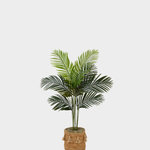Landscape Design
Bring More Balance to Your Garden With Symmetry
See 11 examples that use this classic design principle
Well-designed gardens often use symmetry in a variety of ways to create a sense of harmony. While symmetry is perhaps best illustrated by formal gardens, it’s a design principle that can be used to create balance in any style of garden, from classical to modern. From the nearly perfect symmetry of two potted boxwoods placed on either side of a gate to a more approximate symmetry of loosely mirrored perennial beds, here are 10 ways to add symmetry to your garden.
Create a welcoming entryway. Symmetry in the front yard in the form of two trees flanking the front walk or a pair of pots by the door is a great way to increase curb appeal. The front garden of this beachside bungalow in Southern California strikes a balance between formal and carefree with symmetrical plantings made up of a mix of clipped shrubs and informal, billowing grasses.
Define a central axis. For a classic formal look, set out an axis of symmetry along a sightline of the garden and mirror the planting beds on either side. Not every element of the garden needs to be perfectly symmetrical. Here, a curved rock wall with a built-in bench on the right side of the fountain creates a seating area for taking in the view. The overall effect is cool, calm and serene.
Plant a tree allée. Traditionally, a tree “avenue” consists of a single type of tree planted at regular intervals on either side of a straight path. This classic French style creates structure and can be an opportunity to use symmetry. Here, an allée of strawberry trees (Arbutus ‘Marina’, USDA zones 7 to 10; find your zone) frames a view of a Spanish-style home.
Ground a seating area. Outdoor furniture can feel plunked-down and unrelated to the landscape without plants and design elements to anchor it in place.
This courtyard in London uses the radial symmetry of circular planting beds and brick paving to ground the table. Mirror plantings on either side of the garden gate and pairs of potted boxwoods in the foreground and roses in the background enhance the pleasing symmetry of the design.
This courtyard in London uses the radial symmetry of circular planting beds and brick paving to ground the table. Mirror plantings on either side of the garden gate and pairs of potted boxwoods in the foreground and roses in the background enhance the pleasing symmetry of the design.
Create a garden backdrop. A symmetrical backdrop sets the stage for the rest of the garden. Keep the look formal with clipped turf and tidy hedges or introduce a wilder, more natural aesthetic with ornamental grasses and airy perennials. Either way, the garden design will be anchored by an ordered backdrop.
Two pairs of symmetrical trees planted on either side of a garden statue look peaceful and composed in the Tennessee landscape seen here.
Two pairs of symmetrical trees planted on either side of a garden statue look peaceful and composed in the Tennessee landscape seen here.
Mirror perennial plantings. You could draw a line down the center of this English garden and one side would be an approximate mirror image of the other, like two wings of a butterfly. The hedges and hardscape emphasize the formal symmetry, while the perennial beds themselves are loose and meadow-like. If you look closely, you’ll see that even the clumps of purple lavender and silver lamb’s ears are symmetrical in the beds on both sides.
Mark the entrance to a garden room. Transitions between garden areas are opportunities to use symmetry. Place urns on either side of a gate or mark an entryway with mirrored plantings. Here, two golden-leafed shrubs define the transition between a formal parterre to an expanse of lawn beyond.
Anchor a garden gate. Formal symmetry might seem out of place in a wild, tropical garden with meadow-like grasses and brightly colored foliage, but it successfully adds balance to the design of this San Francisco garden. Two beaten ceramic urns filled with bold tropical foliage add visual weight to the sides of a Balinese gate and ground the entrance to the garden.
Use with contemporary architecture. Symmetrical plantings look clean and sophisticated, making them a natural choice for contemporary homes. In this sleek urban courtyard, pollarded London plane trees (Platanus x acerifolia, zones 5 to 9) are planted in a quadrant to form a shade canopy. Symmetrical planting beds of clipped boxwood form the foundation plants for the wood-paneled home gym.
The front courtyard of this contemporary home in Aptos, California, features symmetrical planting beds of fruitless olive trees (Olea europaea ‘Swan Hill’, zones 8 to 11) and ornamental grasses for a stylish low-water entryway.
Add order to edible gardens. At their peak, veggies like rambling squashes and towering tomatoes can look a bit unruly. Use symmetry in the form of mirrored planting beds or a pair of trellises for climbing vines to help balance wildness with order.
Find more landscape ideas
Find more landscape ideas










